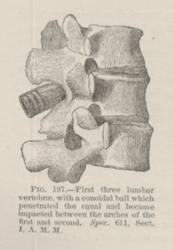Title: R——, Joseph
Source text: Surgeon General Joseph K. Barnes, United States Army, The Medical and Surgical History of the War of the Rebellion. (1861–65.), Part 1, Volume 2 (Washington, D.C.: Government Printing Office, 1870), 444.
Civil War Washington ID: med.d1e18885
TEI/XML: med.d1e18885.xml
CASE.—Private Joseph R——, Co. I, 86th New York Volunteers, stout, muscular, and aged 19 years, was admitted to Emory Hospital, Washington, August 25th, 1862, for a gunshot wound of the back, received on the night of the 22d. Notwithstanding great pain and restlessness, he gave an interesting account of the manner in which he was wounded, even laughing and jesting at times. He stated that, not thinking himself hurt, at the time of receiving the wound, he walked some distance to a tree where he sat and watched the enemy until near morning, when he walked into camp, and, on examination, "found a hole in his blouse and then a hole in his back." Being night when he was admitted, an anodyne was prescribed, and cold applications were applied to the wound. August 26th: passed a restless night, and morning found him wearied and anxious, very restless, with an occasional tetanic spasm, though not severe. He was now chloroformed, the wound was enlarged, and an unsuccessful search was made for the ball. The patient being removed to more comfortable quarters, an assistant and a nurse were left with him with directions to keep him partially etherized until more experienced surgical assistance could be secured. The services of Surgeon R. H. Coolidge were shortly obtained, and, after a trial of more than one hour, he succeeded in removing the ball, which was found firmly impacted in the canal and between the spinous processes of the first and second lumbar vertebræ. After carefully removing all spiculæ of bone, the wound was drawn together by adhesive straps, and cold-water dressings were applied. The administration of an enema of assafœtidæ and turpentine left the patient in a profound sleep, disturbed occasionally, however, by slight spasms of short duration. August 27th: bowels acted twice at night; micturition free and no symptoms of paralysis. There was marked increase in the severity of the tetanic symptoms. The enema was repeated, but had little or no effect in quieting the nervous symptoms. Chloroform was now brought to his relief and its use continued until ten o'clock A. M., when he died. At the autopsy, the ball was found to have destroyed entirely the spinous process of the second lumbar vertebra, and to have buried itself, apex foremost, completely in the vertebral canal, bruising and pressing upon the cord. The case is one of interest from the fact that no symptoms of paralysis followed such an injury to the spinal cord as was here received, and the ball was not turned in its course by the sharp edge of the spinous process. The pathological specimen, figured in the adjoining wood-cut, was contributed to the Army Medical Museum, with the above account, by Acting Assistant Surgeon S. R. Skillern.


